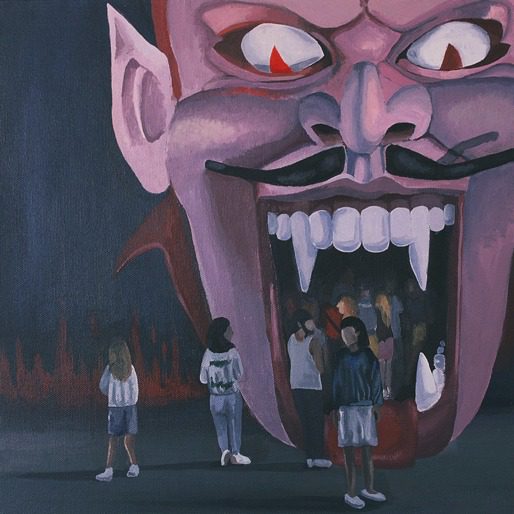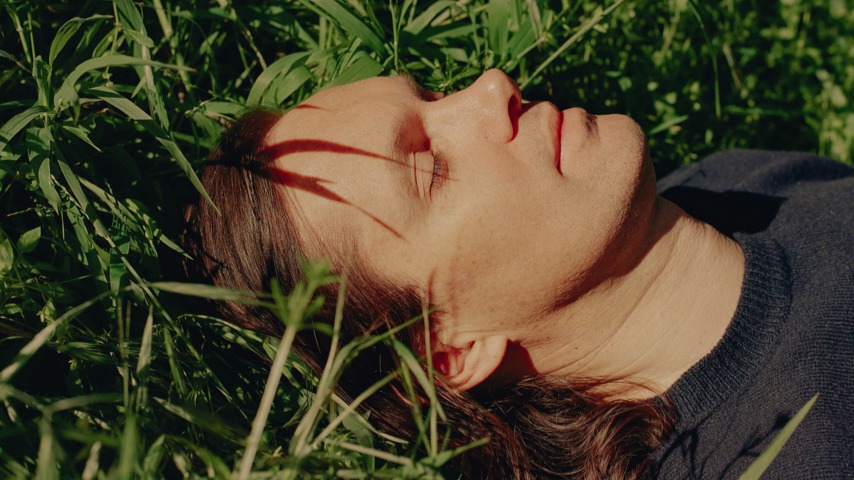We all know how special it feels to fall in love with an album on the very first listen. There’s also something equally special about music that hits the brain from such an unfamiliar angle that it takes a while to even recognize whether you like it or not. There will undoubtedly be listeners whose experience with Spirit of the Beehive’s fourth album ENTERTAINMENT, DEATH falls into the first category, but those people will miss out on the satisfaction of gradually wrapping their head around the band’s Saddle Creek debut.
Since releasing their self-titled first album in 2014, Spirit of the Beehive have used disorientation as one of their primary musical devices. But even fans already accustomed to the Philadelphia outfit’s arsenal of curve balls should expect to find themselves confused this time out. It’s not that Spirit of the Beehive’s music is all that difficult to describe—or incoherent, or even especially inaccessible. Over a series of shifting lineups, the band has (more or less) married rustic folk-rock to an indie-rock ethos splashed with copious amounts of electronic window dressing. (That’s the simple explanation, anyway.)
On “monumental shame,” for example—a track from the band’s last album, 2018’s Hypnic Jerks—Spirit of the Beehive channeled Grateful Dead/Crosby, Stills & Nash vibes through a post-millennial filter. Seems straightforward enough, right? Haven’t countless artists achieved this same exact fusion of styles? Well, no—not like this. There’s something almost alien about the way Spirit of the Beehive inhabit various genre guises, as if the band is completely detached from any awareness of the cultural and temporal context for those genres.
Remember the inscrutable facial expression of the extraterrestrial character played by Jeff Bridges’ character in John Carpenter’s 1984 film Starman? Musically speaking, that’s how Spirit of the Beehive carry themselves when they explore various sounds we’ve been conditioned to associate with a million other things. It’s this utter lack of allegiance to skin-deep aesthetics that makes Spirit of the Beehive’s music so beguiling.
Far too many bands mistake style for substance, consciously attempting to re-create the aura of past musical movements, as if music were a time machine. In 2021, it’s all too easy to make music that instantly transports listeners to the past the way aging film reels and VHS tape do. And it takes zero imagination for musicians to go garage-sale’ing through old boxes for sonic artifacts. Spirit of the Beehive go a step further, crafting sounds that function less as a series of songs and more like dreams.
Dreams, though they play on our memories, mostly feel strangely unmoored from time. They also unfold in non-linear fashion, with a fluidity that’s impossible to experience in waking life. ENTERTAINMENT, DEATH, however, comes pretty close. Overall, the album sounds very much like the same group that has always deconstructed the idea of song structure, its older songs strewn with abrupt changes in barometric pressure via creative knob-twiddling on the mixing console, along with nonsensical samples flowing through them like a current of psychic space junk.
This time, though, Spirit of the Beehive proceed further into the abstract shadings of previous work, zooming-in on atmospheres that in the past would have occupied the interludes between their songs. Here, there’s little that one would classify as a “song,” per se. And if you’ve caught the band live as a five-piece over the last handful of years, you’ll have a hard time finding that band on ENTERTAINMENT, DEATH. It would appear, in fact, as if Spirit of the Beehive have completely let go of sounding like a band at all. After downsizing to a trio, remaining members Zack Schwartz, Rivka Ravede and Corey Wichlin have largely traded in live drums for space—lots and lots of it.
Here, though, space doesn’t consist merely of open gaps in the arrangements as a means for creating ambience. In the hands of Schwartz, Ravede and Wichlin, musical “space” becomes a gateway to another realm of perception entirely. Opening track “ENTERTAINMENT,” for example, begins with nearly a minute’s worth of shape-shifting sonic clamor before guitar strums from Schwartz, bird sounds and a flickering keyboard haze open up onto a warped approximation of “Hawaiian”-style exotica.
The mood morphs yet again when all of a sudden we find ourselves in the midst of what sounds like a verse section in the traditional singer/songwriter mold, with guitar and vocals augmented by strings. The track never transitions from its “verse” to anything resembling a chorus or a bridge, or even a buildup to anything else. Instead, the band simply hovers for a moment before giving way to the electronic dance beat that guides Ravede’s vocals on “THERE’S NOTHING YOU CAN’T DO,” which gets to something like a goth-shoegaze chorus before the music is consumed by a rising swirl of guitar distortion and screaming.
Next, “WRONG CIRCLE” actually presents itself as a song—or at least the illusion of a song—by repeating its “chorus” section, which somehow recalls experimental ‘80s pop a là Peter Gabriel, but without any of the sensations you’d associate with that period or style. For most of the album, though, Spirit of the Beehive tend to stick to a single idea just long enough to tantalize, always deferring gratification by nudging the songs forward a hair too soon, as if the band wanted the album to simulate a sustained state of entropic (if delicate) decay.
Though bold, this approach is bound to alienate listeners who latch onto the airy beauty of the ideas that seed the main sections of tracks like “WRONG CIRCLE,” “BAD SON,” “GIVE UP YOUR LIFE,” “RAPID & COMPLETE RECOVERY” and “THE SERVER IS IMMERSED”—all of which showcase the band’s undeniable ability to write sublime music, the kind that always brings back vivid memories of the first time you heard it. On “GIVE UP YOUR LIFE,” in particular, Ravede’s melodious bass chords combine with Schwartz’s melancholy lead vocal for such a moving, bittersweet effect that you can envision film directors falling all over themselves for permission to use the song.
Clearly, though, Spirit of the Beehive have chosen not to allow listeners to get comfortable for very long on ENTERTAINMENT, DEATH—or perhaps they’re affording listeners the opportunity to get comfortable with perpetual change. By partially obscuring these songs in vaporwave- and glitch-influenced outerwear, however, the band runs the risk of dating this material. To be fair, Spirit of the Beehive are not trend-chasers. The fact that they might appear a decade late to this kind of musical direction is an illusion—ENTERTAINMENT, DEATH proves that Spirit of the Beehive can make any sound from any genre their own, whether it’s a genre that was trending ten years ago or a hundred years ago.
Certainly, Spirit of the Beehive have sacrificed something—namely, the songs that got buried in this album—in the name of progress. That said, ENTERTAINMENT, DEATH most definitely deserves a heap of credit for its originality alone. After establishing themselves as one of the most unique acts on the indie-rock landscape for three albums in a row, it’s heartening to see Spirit of the Beehive take their music even further. Their vision fits right into the lineage of trailblazers they’ve joined by aligning with Saddle Creek, and their first contribution for the label makes for a most worthy addition to its roster.
Saby Reyes-Kulkarni is a longtime contributor at Paste. He believes that a music journalist’s job is to guide readers to their own impressions of the music. He also dreams of being a “setlist doctor” to the bands you read about in these pages, and has started making playlists for imaginary shows that your favorite band never actually played. You can read his work, listen to his interviews and playlists at feedbackdef.com, and find him on Twitter.




